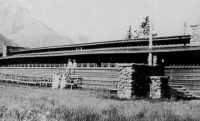Architect Michael Schwarting probably had little idea of the years he would devote to the future of a Modernist prefab prototype when he first came in contact with the Aluminaire House 30 years ago. Nor did Frances Campani, his wife and business partner, who soon found herself involved in a major salvaging effort.
The metal-skinned, steelframe structure was designed in 1931 by Lawrence Kocher and the Swiss émigré Albert Frey for a show held at the Grand Central Palace exposition hall in New York. Philip Johnson and Henry-Russell Hitchcock included the design in their International Style exhibition at the Museum of Modern Art in 1932. The residence also caught the attention of architect Wallace Harrison, who bought it for the grounds of his Long Island estate. But by the late 1980s, Harrison’s property had changed hands, and the new owner planned to demolish the structure.
Enter Schwarting, chair of the architecture department at the New York Institute of Technology’s (NYIT) Central Islip campus. Through his efforts, NYIT was able to dismantle and move the house in 1987. Over the next decade, Schwarting, Campani, and their students slowly rebuilt the house on the school’s campus. When it was closed in 2004, however, the house was again orphaned. Schwarting and Campani created the Aluminaire House Foundation [AHF], to which NYIT gave the structure. After looking for a location, the two now plan to reassemble it in Palm Springs, California. RECORD spoke with Schwarting and Campani after the parts and pieces were trucked across country, just in time for the city’s annual Modernism Week.
Architectural Record: How did the Aluminaire House end up going to Palm Springs?
Schwarting: We were hoping the house would be rebuilt in Queens—across from the Sunnyside Gardens and Phipps Gardens housing— and stay in New York. But the community was wary about its fitting in, and it did not get a New York City Landmarks Commission approval. Around that time, Frances and I gave a lecture in Palm Springs, where houses by Albert Frey are plentiful because he moved there in the mid-1930s. When we mentioned the problems of the Aluminaire House’s future, people in the audience said, “Bring it to Palm Springs!”
In 2012, we had already dismantled the house and put the contents into a 45-footlong tractor-trailer, which we stored on Long Island. All we had to do was get a truck driver.
Where will it land there?
Schwarting: In the downtown— near the Palm Springs Art Museum—there is some city land where a mall was torn down. We have been talking to the city about giving the land to the Aluminaire House Foundation in California, created two years ago. Negotiations with the city are still going on, but the $600,000 reconstruction will be paid by the foundation, which has been organizing fundraisers.
Campani: We were so struck by the deep interest in the Aluminaire House, and the location of this desert site, it seemed worth the risk. We have an agreement with the California AHF that, if the arrangement doesn’t work, the Aluminaire House will return to New York.
What will be your roles if it is rebuilt in Palm Springs?
Campani: We will be involved as the architects for the reconstruction. We have construc- tion drawings we made based on archival material, and lots of hands-on familiarity.
So how long should we wait before seeing this reincarnation?
Schwarting: Once the site situation is solved, we hope to construct it within a year. If Kocher and Frey could build the Aluminaire House within Grand Central Palace in 10 days, we should be able to do this. For now, it’s a big pile of bolts and parts. You are now the parents for this “house with- out a home.”
Will you be able to say good-bye?
Schwarting: Never.
Campani: It will be sent off to another mother.









Post a comment to this article
Report Abusive Comment